MERCEDES-BENZ SPRINTER 2006 Service Manual
Manufacturer: MERCEDES-BENZ, Model Year: 2006, Model line: SPRINTER, Model: MERCEDES-BENZ SPRINTER 2006Pages: 2305, PDF Size: 48.12 MB
Page 171 of 2305
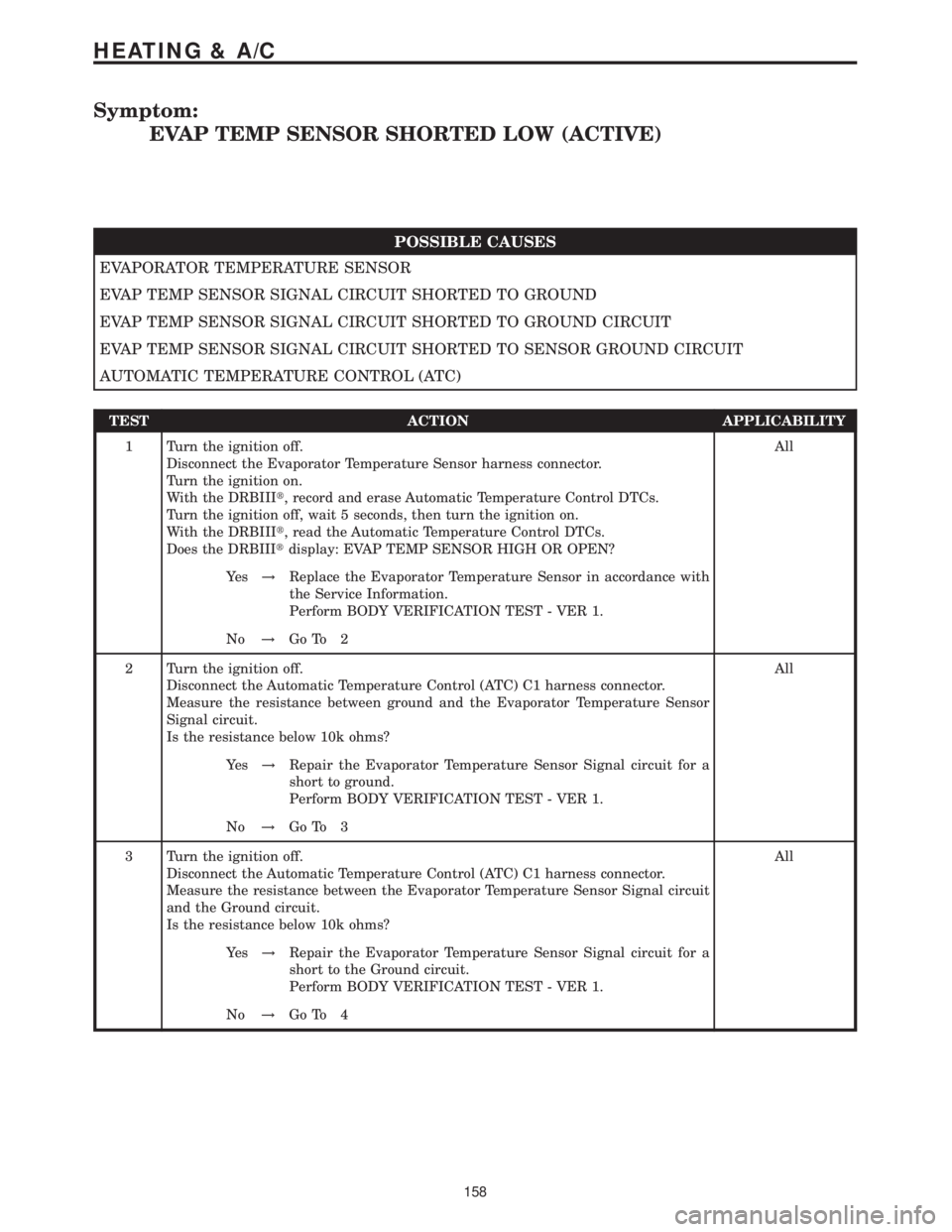
Symptom:
EVAP TEMP SENSOR SHORTED LOW (ACTIVE)
POSSIBLE CAUSES
EVAPORATOR TEMPERATURE SENSOR
EVAP TEMP SENSOR SIGNAL CIRCUIT SHORTED TO GROUND
EVAP TEMP SENSOR SIGNAL CIRCUIT SHORTED TO GROUND CIRCUIT
EVAP TEMP SENSOR SIGNAL CIRCUIT SHORTED TO SENSOR GROUND CIRCUIT
AUTOMATIC TEMPERATURE CONTROL (ATC)
TEST ACTION APPLICABILITY
1 Turn the ignition off.
Disconnect the Evaporator Temperature Sensor harness connector.
Turn the ignition on.
With the DRBIIIt, record and erase Automatic Temperature Control DTCs.
Turn the ignition off, wait 5 seconds, then turn the ignition on.
With the DRBIIIt, read the Automatic Temperature Control DTCs.
Does the DRBIIItdisplay: EVAP TEMP SENSOR HIGH OR OPEN?All
Ye s!Replace the Evaporator Temperature Sensor in accordance with
the Service Information.
Perform BODY VERIFICATION TEST - VER 1.
No!Go To 2
2 Turn the ignition off.
Disconnect the Automatic Temperature Control (ATC) C1 harness connector.
Measure the resistance between ground and the Evaporator Temperature Sensor
Signal circuit.
Is the resistance below 10k ohms?All
Ye s!Repair the Evaporator Temperature Sensor Signal circuit for a
short to ground.
Perform BODY VERIFICATION TEST - VER 1.
No!Go To 3
3 Turn the ignition off.
Disconnect the Automatic Temperature Control (ATC) C1 harness connector.
Measure the resistance between the Evaporator Temperature Sensor Signal circuit
and the Ground circuit.
Is the resistance below 10k ohms?All
Ye s!Repair the Evaporator Temperature Sensor Signal circuit for a
short to the Ground circuit.
Perform BODY VERIFICATION TEST - VER 1.
No!Go To 4
158
HEATING & A/C
Page 172 of 2305
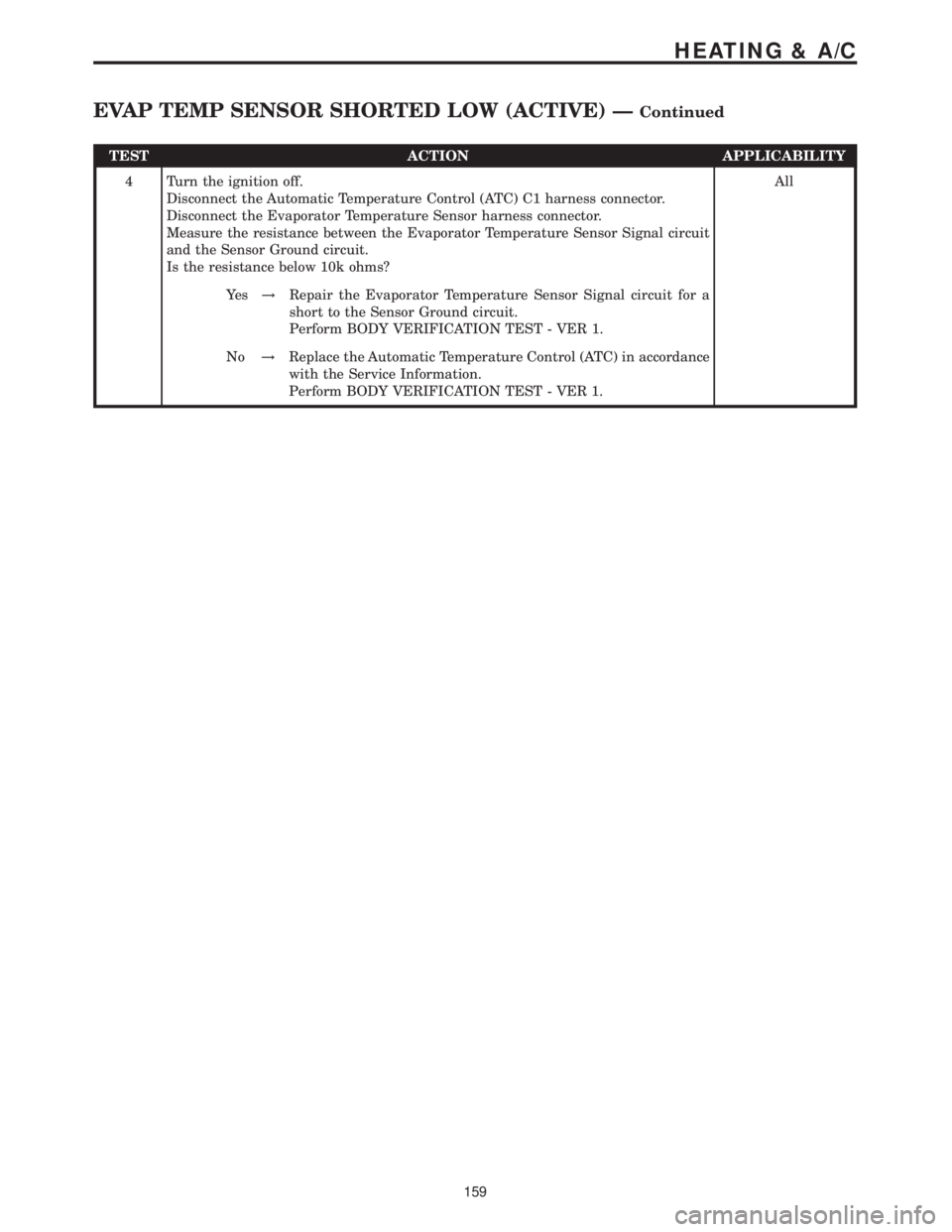
TEST ACTION APPLICABILITY
4 Turn the ignition off.
Disconnect the Automatic Temperature Control (ATC) C1 harness connector.
Disconnect the Evaporator Temperature Sensor harness connector.
Measure the resistance between the Evaporator Temperature Sensor Signal circuit
and the Sensor Ground circuit.
Is the resistance below 10k ohms?All
Ye s!Repair the Evaporator Temperature Sensor Signal circuit for a
short to the Sensor Ground circuit.
Perform BODY VERIFICATION TEST - VER 1.
No!Replace the Automatic Temperature Control (ATC) in accordance
with the Service Information.
Perform BODY VERIFICATION TEST - VER 1.
159
HEATING & A/C
EVAP TEMP SENSOR SHORTED LOW (ACTIVE) ÐContinued
Page 173 of 2305
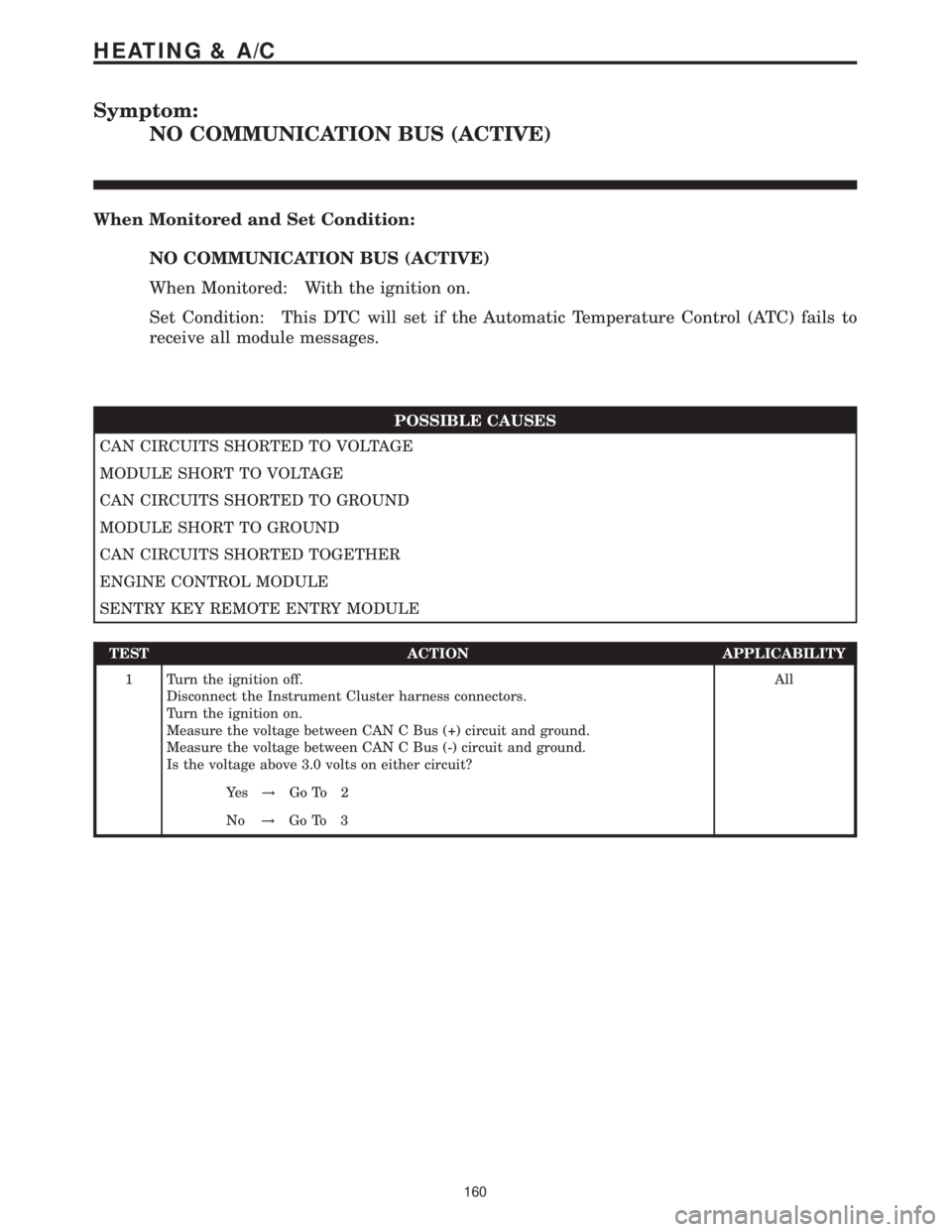
Symptom:
NO COMMUNICATION BUS (ACTIVE)
When Monitored and Set Condition:
NO COMMUNICATION BUS (ACTIVE)
When Monitored: With the ignition on.
Set Condition: This DTC will set if the Automatic Temperature Control (ATC) fails to
receive all module messages.
POSSIBLE CAUSES
CAN CIRCUITS SHORTED TO VOLTAGE
MODULE SHORT TO VOLTAGE
CAN CIRCUITS SHORTED TO GROUND
MODULE SHORT TO GROUND
CAN CIRCUITS SHORTED TOGETHER
ENGINE CONTROL MODULE
SENTRY KEY REMOTE ENTRY MODULE
TEST ACTION APPLICABILITY
1 Turn the ignition off.
Disconnect the Instrument Cluster harness connectors.
Turn the ignition on.
Measure the voltage between CAN C Bus (+) circuit and ground.
Measure the voltage between CAN C Bus (-) circuit and ground.
Is the voltage above 3.0 volts on either circuit?All
Ye s!Go To 2
No!Go To 3
160
HEATING & A/C
Page 174 of 2305
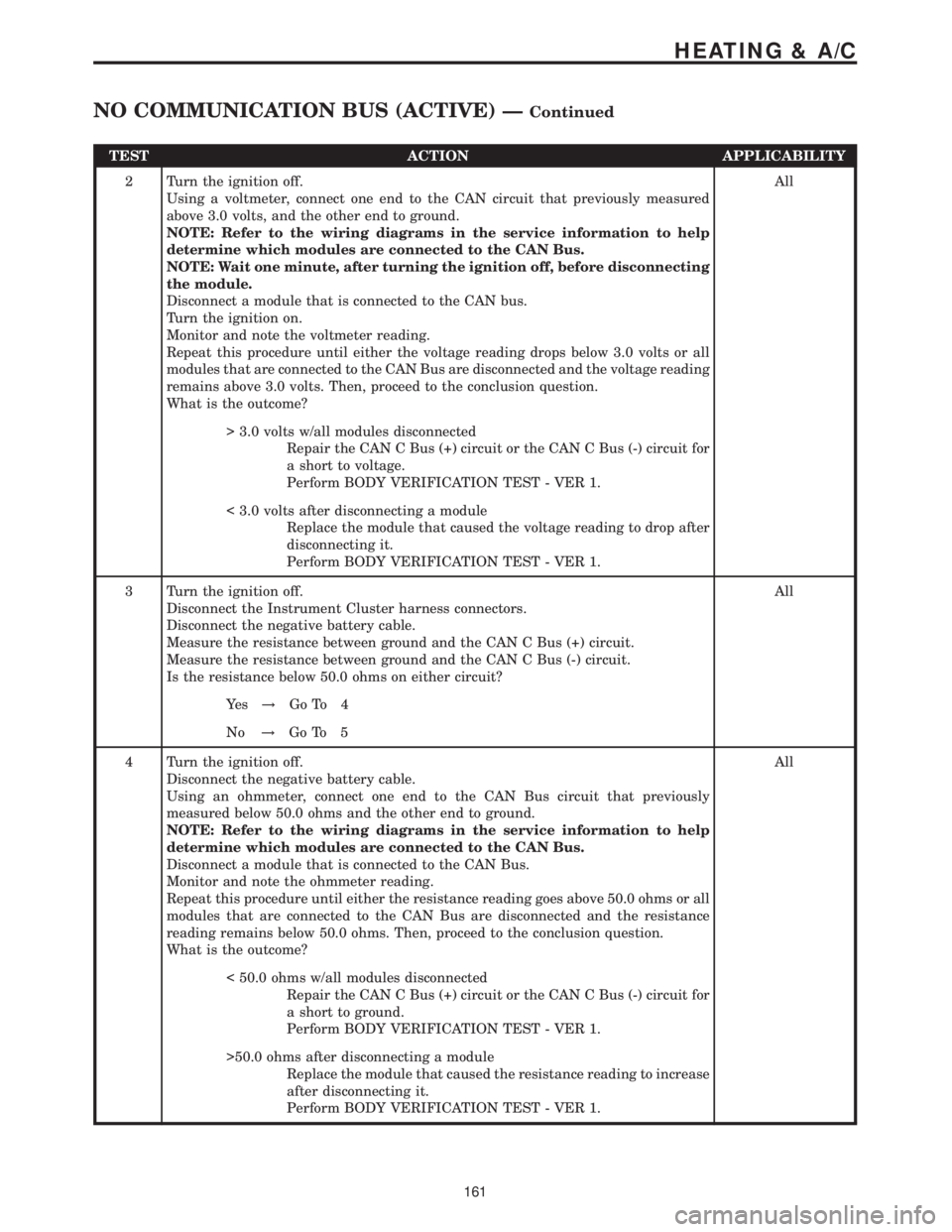
TEST ACTION APPLICABILITY
2 Turn the ignition off.
Using a voltmeter, connect one end to the CAN circuit that previously measured
above 3.0 volts, and the other end to ground.
NOTE: Refer to the wiring diagrams in the service information to help
determine which modules are connected to the CAN Bus.
NOTE: Wait one minute, after turning the ignition off, before disconnecting
the module.
Disconnect a module that is connected to the CAN bus.
Turn the ignition on.
Monitor and note the voltmeter reading.
Repeat this procedure until either the voltage reading drops below 3.0 volts or all
modules that are connected to the CAN Bus are disconnected and the voltage reading
remains above 3.0 volts. Then, proceed to the conclusion question.
What is the outcome?All
> 3.0 volts w/all modules disconnected
Repair the CAN C Bus (+) circuit or the CAN C Bus (-) circuit for
a short to voltage.
Perform BODY VERIFICATION TEST - VER 1.
< 3.0 volts after disconnecting a module
Replace the module that caused the voltage reading to drop after
disconnecting it.
Perform BODY VERIFICATION TEST - VER 1.
3 Turn the ignition off.
Disconnect the Instrument Cluster harness connectors.
Disconnect the negative battery cable.
Measure the resistance between ground and the CAN C Bus (+) circuit.
Measure the resistance between ground and the CAN C Bus (-) circuit.
Is the resistance below 50.0 ohms on either circuit?All
Ye s!Go To 4
No!Go To 5
4 Turn the ignition off.
Disconnect the negative battery cable.
Using an ohmmeter, connect one end to the CAN Bus circuit that previously
measured below 50.0 ohms and the other end to ground.
NOTE: Refer to the wiring diagrams in the service information to help
determine which modules are connected to the CAN Bus.
Disconnect a module that is connected to the CAN Bus.
Monitor and note the ohmmeter reading.
Repeat this procedure until either the resistance reading goes above 50.0 ohms or all
modules that are connected to the CAN Bus are disconnected and the resistance
reading remains below 50.0 ohms. Then, proceed to the conclusion question.
What is the outcome?All
< 50.0 ohms w/all modules disconnected
Repair the CAN C Bus (+) circuit or the CAN C Bus (-) circuit for
a short to ground.
Perform BODY VERIFICATION TEST - VER 1.
>50.0 ohms after disconnecting a module
Replace the module that caused the resistance reading to increase
after disconnecting it.
Perform BODY VERIFICATION TEST - VER 1.
161
HEATING & A/C
NO COMMUNICATION BUS (ACTIVE) ÐContinued
Page 175 of 2305
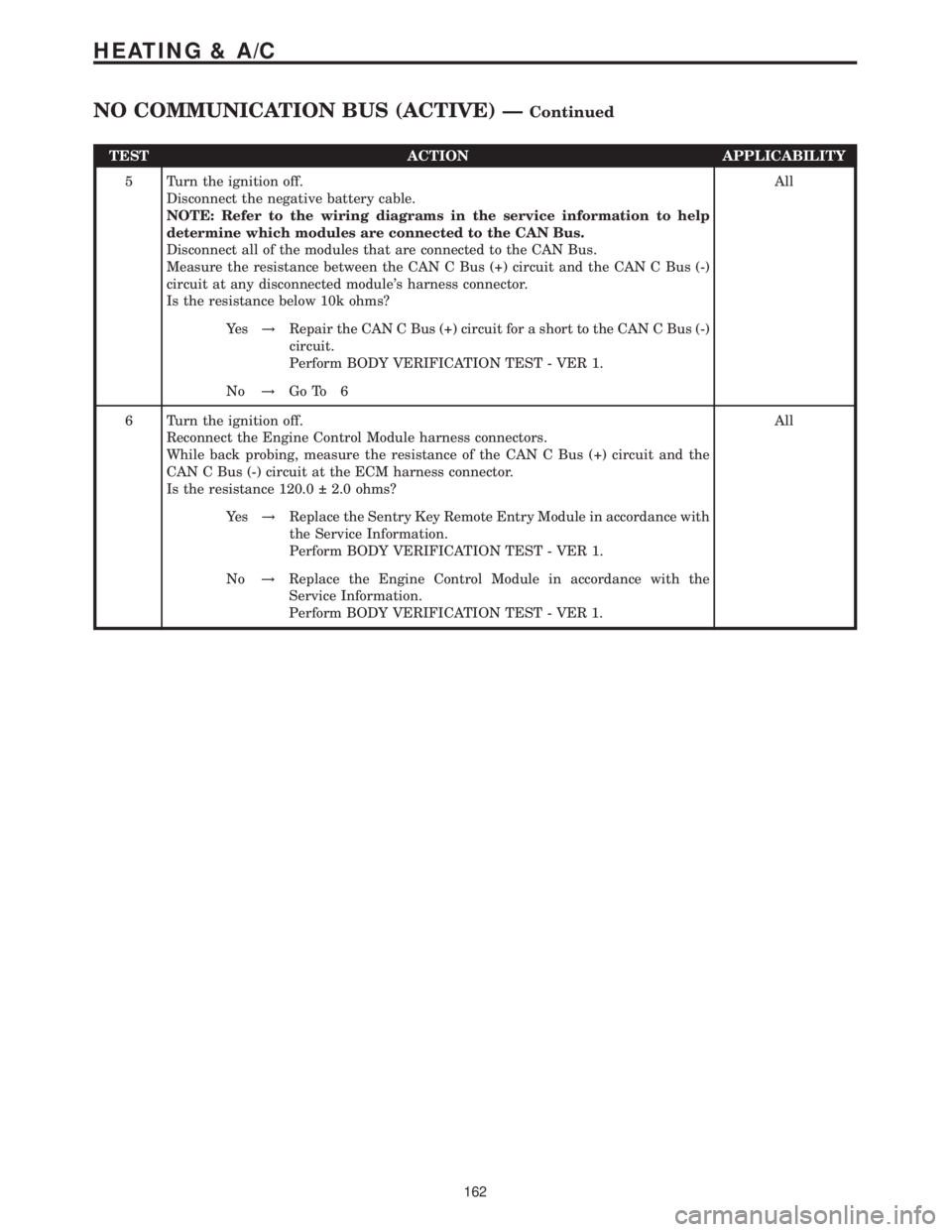
TEST ACTION APPLICABILITY
5 Turn the ignition off.
Disconnect the negative battery cable.
NOTE: Refer to the wiring diagrams in the service information to help
determine which modules are connected to the CAN Bus.
Disconnect all of the modules that are connected to the CAN Bus.
Measure the resistance between the CAN C Bus (+) circuit and the CAN C Bus (-)
circuit at any disconnected module's harness connector.
Is the resistance below 10k ohms?All
Ye s!Repair the CAN C Bus (+) circuit for a short to the CAN C Bus (-)
circuit.
Perform BODY VERIFICATION TEST - VER 1.
No!Go To 6
6 Turn the ignition off.
Reconnect the Engine Control Module harness connectors.
While back probing, measure the resistance of the CAN C Bus (+) circuit and the
CAN C Bus (-) circuit at the ECM harness connector.
Is the resistance 120.0 2.0 ohms?All
Ye s!Replace the Sentry Key Remote Entry Module in accordance with
the Service Information.
Perform BODY VERIFICATION TEST - VER 1.
No!Replace the Engine Control Module in accordance with the
Service Information.
Perform BODY VERIFICATION TEST - VER 1.
162
HEATING & A/C
NO COMMUNICATION BUS (ACTIVE) ÐContinued
Page 176 of 2305
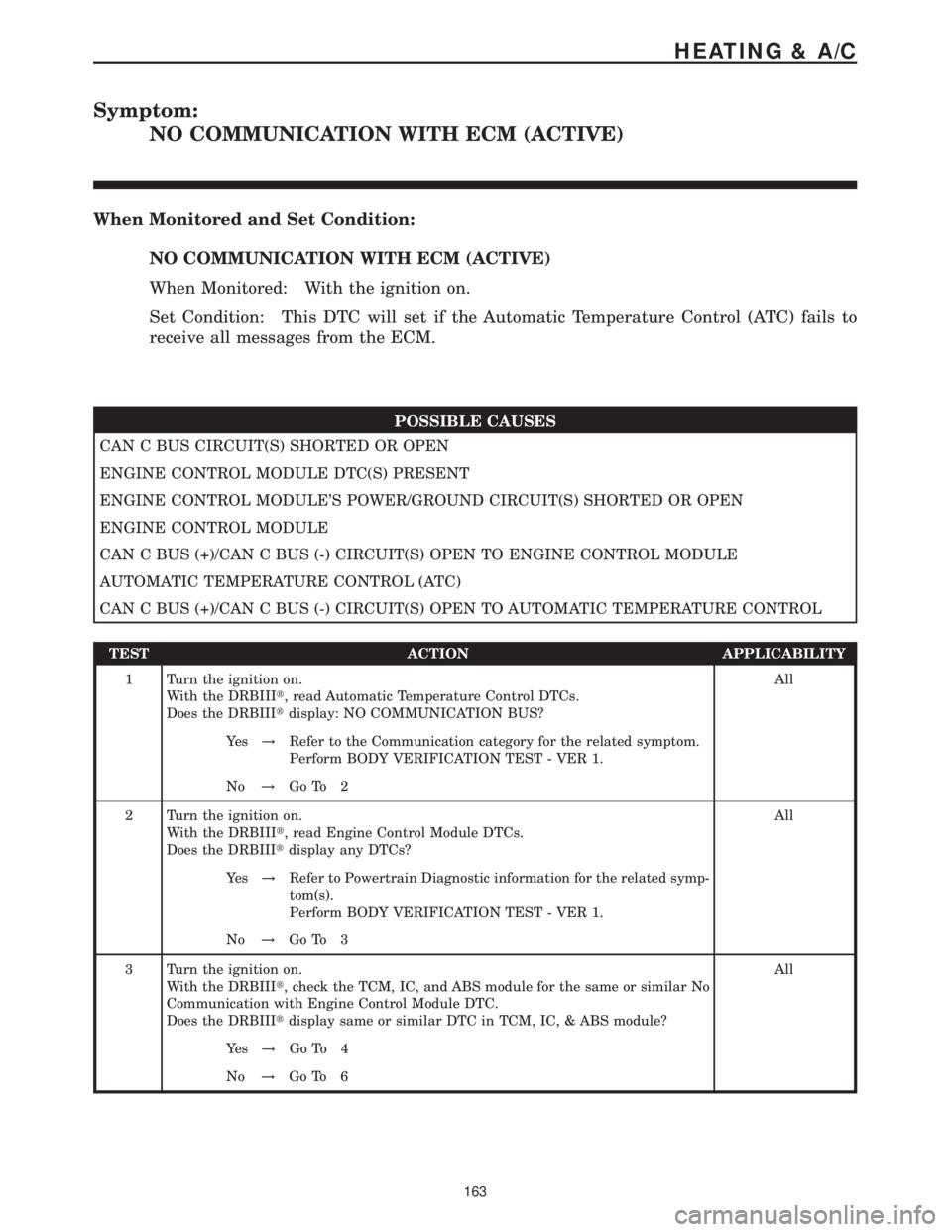
Symptom:
NO COMMUNICATION WITH ECM (ACTIVE)
When Monitored and Set Condition:
NO COMMUNICATION WITH ECM (ACTIVE)
When Monitored: With the ignition on.
Set Condition: This DTC will set if the Automatic Temperature Control (ATC) fails to
receive all messages from the ECM.
POSSIBLE CAUSES
CAN C BUS CIRCUIT(S) SHORTED OR OPEN
ENGINE CONTROL MODULE DTC(S) PRESENT
ENGINE CONTROL MODULE'S POWER/GROUND CIRCUIT(S) SHORTED OR OPEN
ENGINE CONTROL MODULE
CAN C BUS (+)/CAN C BUS (-) CIRCUIT(S) OPEN TO ENGINE CONTROL MODULE
AUTOMATIC TEMPERATURE CONTROL (ATC)
CAN C BUS (+)/CAN C BUS (-) CIRCUIT(S) OPEN TO AUTOMATIC TEMPERATURE CONTROL
TEST ACTION APPLICABILITY
1 Turn the ignition on.
With the DRBIIIt, read Automatic Temperature Control DTCs.
Does the DRBIIItdisplay: NO COMMUNICATION BUS?All
Ye s!Refer to the Communication category for the related symptom.
Perform BODY VERIFICATION TEST - VER 1.
No!Go To 2
2 Turn the ignition on.
With the DRBIIIt, read Engine Control Module DTCs.
Does the DRBIIItdisplay any DTCs?All
Ye s!Refer to Powertrain Diagnostic information for the related symp-
tom(s).
Perform BODY VERIFICATION TEST - VER 1.
No!Go To 3
3 Turn the ignition on.
With the DRBIIIt, check the TCM, IC, and ABS module for the same or similar No
Communication with Engine Control Module DTC.
Does the DRBIIItdisplay same or similar DTC in TCM, IC, & ABS module?All
Ye s!Go To 4
No!Go To 6
163
HEATING & A/C
Page 177 of 2305
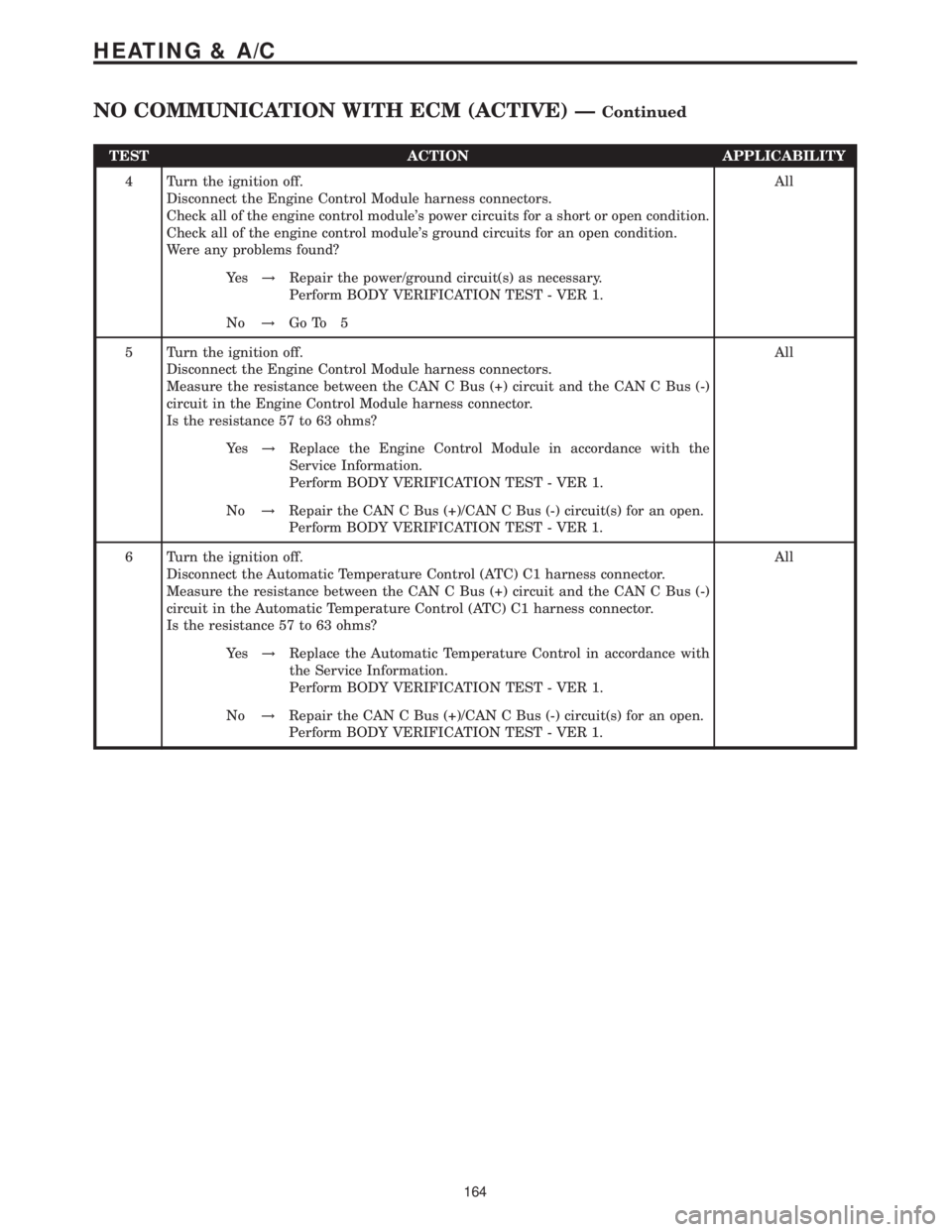
TEST ACTION APPLICABILITY
4 Turn the ignition off.
Disconnect the Engine Control Module harness connectors.
Check all of the engine control module's power circuits for a short or open condition.
Check all of the engine control module's ground circuits for an open condition.
Were any problems found?All
Ye s!Repair the power/ground circuit(s) as necessary.
Perform BODY VERIFICATION TEST - VER 1.
No!Go To 5
5 Turn the ignition off.
Disconnect the Engine Control Module harness connectors.
Measure the resistance between the CAN C Bus (+) circuit and the CAN C Bus (-)
circuit in the Engine Control Module harness connector.
Is the resistance 57 to 63 ohms?All
Ye s!Replace the Engine Control Module in accordance with the
Service Information.
Perform BODY VERIFICATION TEST - VER 1.
No!Repair the CAN C Bus (+)/CAN C Bus (-) circuit(s) for an open.
Perform BODY VERIFICATION TEST - VER 1.
6 Turn the ignition off.
Disconnect the Automatic Temperature Control (ATC) C1 harness connector.
Measure the resistance between the CAN C Bus (+) circuit and the CAN C Bus (-)
circuit in the Automatic Temperature Control (ATC) C1 harness connector.
Is the resistance 57 to 63 ohms?All
Ye s!Replace the Automatic Temperature Control in accordance with
the Service Information.
Perform BODY VERIFICATION TEST - VER 1.
No!Repair the CAN C Bus (+)/CAN C Bus (-) circuit(s) for an open.
Perform BODY VERIFICATION TEST - VER 1.
164
HEATING & A/C
NO COMMUNICATION WITH ECM (ACTIVE) ÐContinued
Page 178 of 2305
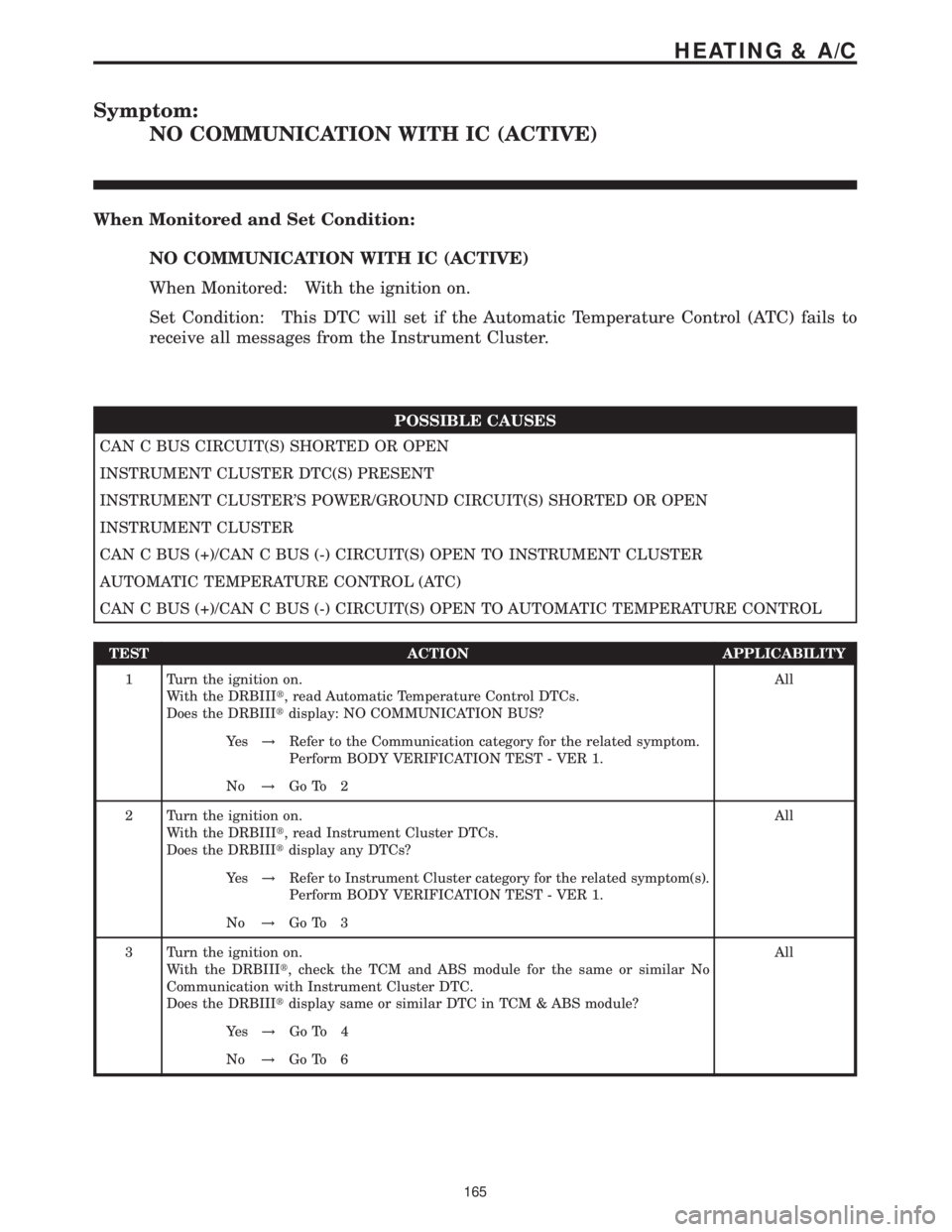
Symptom:
NO COMMUNICATION WITH IC (ACTIVE)
When Monitored and Set Condition:
NO COMMUNICATION WITH IC (ACTIVE)
When Monitored: With the ignition on.
Set Condition: This DTC will set if the Automatic Temperature Control (ATC) fails to
receive all messages from the Instrument Cluster.
POSSIBLE CAUSES
CAN C BUS CIRCUIT(S) SHORTED OR OPEN
INSTRUMENT CLUSTER DTC(S) PRESENT
INSTRUMENT CLUSTER'S POWER/GROUND CIRCUIT(S) SHORTED OR OPEN
INSTRUMENT CLUSTER
CAN C BUS (+)/CAN C BUS (-) CIRCUIT(S) OPEN TO INSTRUMENT CLUSTER
AUTOMATIC TEMPERATURE CONTROL (ATC)
CAN C BUS (+)/CAN C BUS (-) CIRCUIT(S) OPEN TO AUTOMATIC TEMPERATURE CONTROL
TEST ACTION APPLICABILITY
1 Turn the ignition on.
With the DRBIIIt, read Automatic Temperature Control DTCs.
Does the DRBIIItdisplay: NO COMMUNICATION BUS?All
Ye s!Refer to the Communication category for the related symptom.
Perform BODY VERIFICATION TEST - VER 1.
No!Go To 2
2 Turn the ignition on.
With the DRBIIIt, read Instrument Cluster DTCs.
Does the DRBIIItdisplay any DTCs?All
Ye s!Refer to Instrument Cluster category for the related symptom(s).
Perform BODY VERIFICATION TEST - VER 1.
No!Go To 3
3 Turn the ignition on.
With the DRBIIIt, check the TCM and ABS module for the same or similar No
Communication with Instrument Cluster DTC.
Does the DRBIIItdisplay same or similar DTC in TCM & ABS module?All
Ye s!Go To 4
No!Go To 6
165
HEATING & A/C
Page 179 of 2305
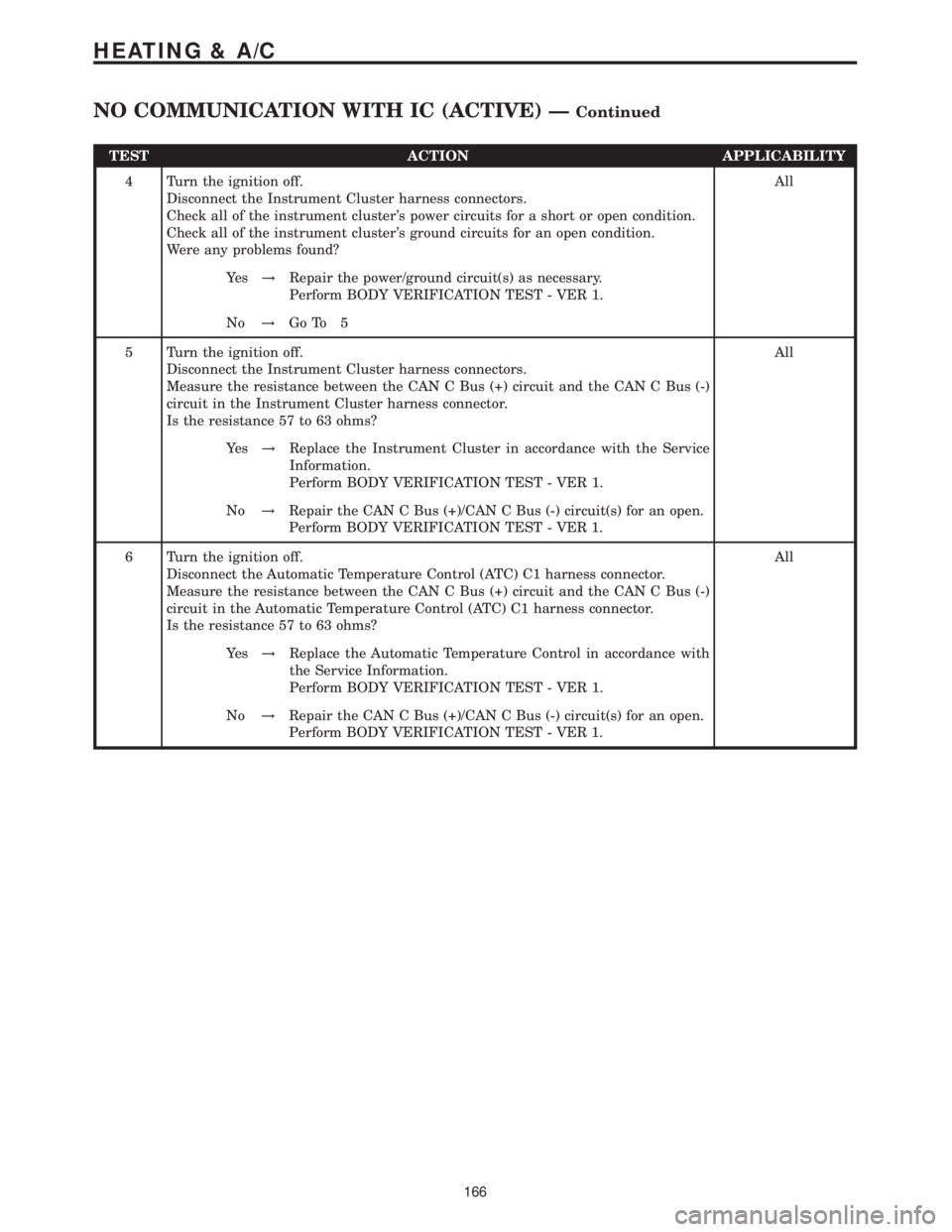
TEST ACTION APPLICABILITY
4 Turn the ignition off.
Disconnect the Instrument Cluster harness connectors.
Check all of the instrument cluster's power circuits for a short or open condition.
Check all of the instrument cluster's ground circuits for an open condition.
Were any problems found?All
Ye s!Repair the power/ground circuit(s) as necessary.
Perform BODY VERIFICATION TEST - VER 1.
No!Go To 5
5 Turn the ignition off.
Disconnect the Instrument Cluster harness connectors.
Measure the resistance between the CAN C Bus (+) circuit and the CAN C Bus (-)
circuit in the Instrument Cluster harness connector.
Is the resistance 57 to 63 ohms?All
Ye s!Replace the Instrument Cluster in accordance with the Service
Information.
Perform BODY VERIFICATION TEST - VER 1.
No!Repair the CAN C Bus (+)/CAN C Bus (-) circuit(s) for an open.
Perform BODY VERIFICATION TEST - VER 1.
6 Turn the ignition off.
Disconnect the Automatic Temperature Control (ATC) C1 harness connector.
Measure the resistance between the CAN C Bus (+) circuit and the CAN C Bus (-)
circuit in the Automatic Temperature Control (ATC) C1 harness connector.
Is the resistance 57 to 63 ohms?All
Ye s!Replace the Automatic Temperature Control in accordance with
the Service Information.
Perform BODY VERIFICATION TEST - VER 1.
No!Repair the CAN C Bus (+)/CAN C Bus (-) circuit(s) for an open.
Perform BODY VERIFICATION TEST - VER 1.
166
HEATING & A/C
NO COMMUNICATION WITH IC (ACTIVE) ÐContinued
Page 180 of 2305
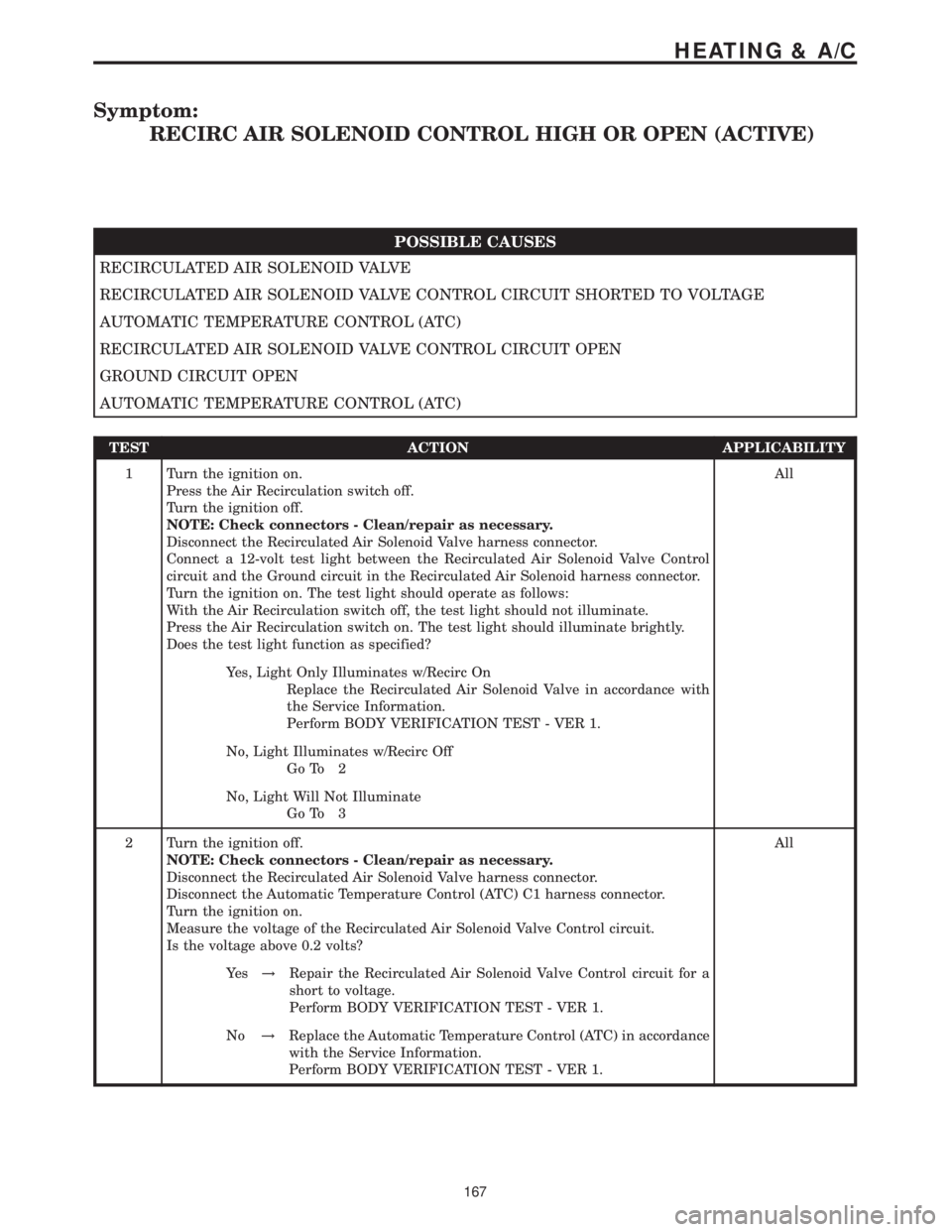
Symptom:
RECIRC AIR SOLENOID CONTROL HIGH OR OPEN (ACTIVE)
POSSIBLE CAUSES
RECIRCULATED AIR SOLENOID VALVE
RECIRCULATED AIR SOLENOID VALVE CONTROL CIRCUIT SHORTED TO VOLTAGE
AUTOMATIC TEMPERATURE CONTROL (ATC)
RECIRCULATED AIR SOLENOID VALVE CONTROL CIRCUIT OPEN
GROUND CIRCUIT OPEN
AUTOMATIC TEMPERATURE CONTROL (ATC)
TEST ACTION APPLICABILITY
1 Turn the ignition on.
Press the Air Recirculation switch off.
Turn the ignition off.
NOTE: Check connectors - Clean/repair as necessary.
Disconnect the Recirculated Air Solenoid Valve harness connector.
Connect a 12-volt test light between the Recirculated Air Solenoid Valve Control
circuit and the Ground circuit in the Recirculated Air Solenoid harness connector.
Turn the ignition on. The test light should operate as follows:
With the Air Recirculation switch off, the test light should not illuminate.
Press the Air Recirculation switch on. The test light should illuminate brightly.
Does the test light function as specified?All
Yes, Light Only Illuminates w/Recirc On
Replace the Recirculated Air Solenoid Valve in accordance with
the Service Information.
Perform BODY VERIFICATION TEST - VER 1.
No, Light Illuminates w/Recirc Off
Go To 2
No, Light Will Not Illuminate
Go To 3
2 Turn the ignition off.
NOTE: Check connectors - Clean/repair as necessary.
Disconnect the Recirculated Air Solenoid Valve harness connector.
Disconnect the Automatic Temperature Control (ATC) C1 harness connector.
Turn the ignition on.
Measure the voltage of the Recirculated Air Solenoid Valve Control circuit.
Is the voltage above 0.2 volts?All
Ye s!Repair the Recirculated Air Solenoid Valve Control circuit for a
short to voltage.
Perform BODY VERIFICATION TEST - VER 1.
No!Replace the Automatic Temperature Control (ATC) in accordance
with the Service Information.
Perform BODY VERIFICATION TEST - VER 1.
167
HEATING & A/C